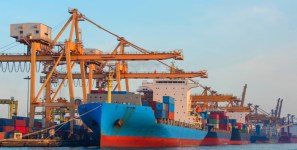TOP CONTAINER PORTS: LA & NY … AND THEN EVERYONE ELSE
The U.S. Army Corps of Engineers compiles annual lists of the top container ports by volume, with the figures for 2018 being the most recently released.
The list shows Los Angeles handled more than 1 million more containers than its neighbor Long Beach did, but Long Beach dealt with nearly a million more than third-place New York/New Jersey did.
That those three occupied the first three U.S. slots on the Army Corps’ list is not surprising to anyone who has followed container traffic in recent years. What may raise eyebrows is how many more containers those ports handle compared to everyone else in the country.
Los Angeles took in 19.5 percent of the nation’s containers in 2018, compared to 17.9 percent the year before. Indeed, Long Beach and New York/New Jersey saw year-to-year growth under the same metrics. Long Beach containers accounted for 16.7 percent of the nation’s total for 2018, up from 14.4 percent the year before. New York/New Jersey grabbed 14.8 percent in ’18, compared to 12.8 percent in ’17.
Combined, Los Angeles and Long Beach, whose ports essentially border one another, accounted for 36.2 percent of the containers handled in America in 2018, up from 32.3 percent the year prior. If you combine the Californians with New York/New Jersey, the three-port complexes handled more than half of the containers in the U.S. in 2018, at 51.1 percent. That’s up from 45.1 percent in 2017.
While Savannah handled more than 2 million fewer containers than New York/New Jersey to land at No. 4, the Georgia Ports Authority port had an impressive growth of 305,760 units from 2017 to ’18, which was better than top dog Los Angeles.
Others who beat LA’s 115k in that metric were (in order of impressiveness): Houston (240k); Jacksonville (237k); Charleston (138k); Seattle/Tacoma, which together form the Northwest Seaport Alliance (132k); and Oakland (125k).
Below is the U.S. Army Corps of Engineers’ list of the top 15 container ports in order, with their totals for 2018, 2017 and how many more containers that represented—because no one on the list handled fewer containers than they did the year before.
Because no 2018 data is indicated for some ports, but their 2017 totals are included, these facilities are indented about where they would fall if they pulled in similar numbers of containers in ’18. However, those ports are not counted among the top 15 as presented by Global Trade.
-Los Angeles
2018: 9,458,749
2017: 9,343,192
+115,557
-Long Beach
2018: 8,091,029
2017: 7,544,507
+546,522
-New York/New Jersey
2018: 7,179,792
2017: 6,710,817
+468,975
-Savannah
2018: 4,351,976
2017: 4,046,216
+305,760
-Seattle/Tacoma Alliance
2018: 3,797,627
2017: 3,665,329
+132,298
-Hampton Roads
2018: 2,855,914
2017: 2,841,016
+14,898
-Houston
2018: 2,699,850
2017: 2,459,107
+240,743
-Oakland
2018: 2,546,357
2017: 2,420,836
+125,521
-Charleston
2018: 2,316,255
2017: 2,177,550
+138,705
-San Juan (Puerto Rico)
2017: 1,319,572
-Jacksonville
2018: 1,270,480
2017: 1,033,070
+237,410
-Honolulu
2017: 1,204,568
-Everglades
2018: 1,108,465
2017: 1,076,893
+31,572
-Miami
2018: 1,084,000
2017: 1,024,338
+59,662
-Baltimore
2018: 1,023,161
2017: 962,484
+60.677
-Philadelphia
2018: 600,000
2017: 545,408
+54,592
-New Orleans
2018: 591,532
2017: 532,597
+58,935





Leave a Reply